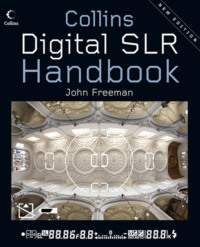Kitap dosya olarak indirilemez ancak uygulamamız üzerinden veya online olarak web sitemizden okunabilir.
Kitabı oku: «Digital SLR Handbook»
Collins
Digital SLR Handbook
John Freeman

Dedication
To Chris Pailthorpe, who never lived to see this book.
Contents
Cover
Title Page
Dedication
Introduction
 The DSLR system
The DSLR system
 Getting to grips with your DSLR
Getting to grips with your DSLR
 Seeing the picture
Seeing the picture
 Landscapes
Landscapes
 Nature
Nature
 People
People
 Architecture
Architecture
 Still life
Still life
 Action
Action
 Getting more from your DSLR
Getting more from your DSLR
 Post-production
Post-production
Resources
Glossary
Index
Acknowledgements
About the Author
Copyright
About the Publisher
Introduction
For many years, the 35mm SLR film camera has been the cornerstone of the serious photographer’s kit but, with a speed that few could have imagined, the digital single lens reflex (DSLR) camera has now taken over its role.
The rise of the DSLR
There are those people who still maintain that the age of digital photography is all about ‘manipulation’ and that photographs produced digitally cannot come close to those printed on bromide in a wet darkroom. While no one would deny that shooting on film, developing it and then making a print is a craft that one spends a lifetime learning, equally no one should underestimate the different skills required to get the best from a digital camera, especially a sophisticated DSLR model.
Digital developments
Since the mid-1970s, when Kodak developed the first solid-state image sensor, the developments in digital photography have been as varied as they have been rapid. Only a few years ago, a compact camera boasting a 2mp (megapixel) image sensor was thought of as state of the art. Comparing that to my Canon EOS 1DS MK3 DSLR, which has a 21.1mp image sensor, it would be foolish to think that the technology will do anything but improve. This camera has now become the centre of my kit, and there are few applications that it can’t cope with just as well as, if not better than, my old film cameras once did.
The DSLR camera body is at the centre of a vast and continually growing system that is perfect for the professional photographer and enthusiastic amateur. Apart from being able to record high-definition images that can be enlarged to billboard-size proportions, the lenses available can be applied to virtually any shooting situation. These range from ultra wide-angle, such as the 180° fisheye lens, through to ultra telephoto lenses of 1000mm or more. In between there is a plethora of other lenses, such as macro, shift and tilt, image stabilizing lenses and more. Then there are the accessories, such as interchangeable focusing screens, macro ring flash, angle finders, underwater housings and so on.
However, just as it was with the old film SLRs or, indeed, with any equipment, it is you, the photographer, that makes the difference. After all, it is your ‘eye’ that sees the picture – the camera can only record it in the way you tell it to. With the help of this book you can learn how to see in a way that will enable you to get the most from your DSLR system.

Light is the lifeblood of photography, and the DSLR system enables you to capture the light at the end of the tunnel probably better than any other camera. Even in difficult situations, such as shooting in this canyon, the DSLR’s ability to record an image in low light is second to none.
> Canon EOS 1DS, 24mm lens, 2 secs, f/11.
Ücretsiz ön izlemeyi tamamladınız.
